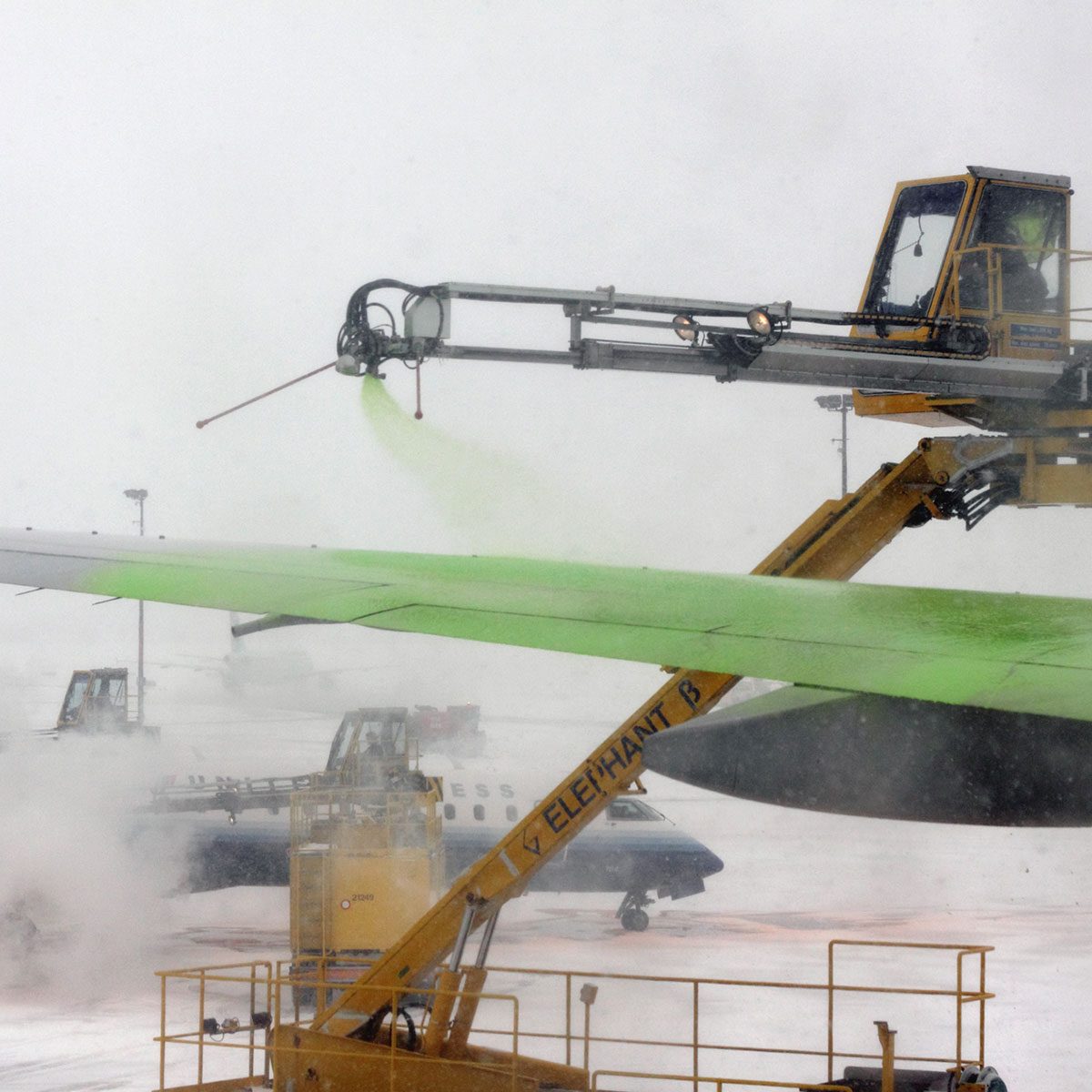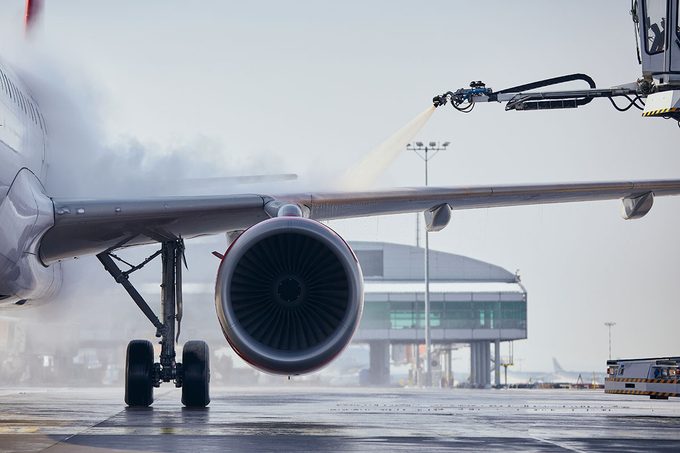Should you panic if your plane is doused in a colorful slime that's as freakily artificial as something out of a sci-fi film?

Here’s What It Means If You See Green Fluid on an Airplane Wing

Fly often enough, and there’s nothing new under the sky—even the worst turbulence can start to feel routine. So I was caught a little off guard the first time I watched, from my window seat, as green goop that would impress the folks at Nickelodeon splashed across the wings of the plane one winter before takeoff from New York to Rome.
Whatever this oozy substance was, it made for a great Instagram video, but it also left me with more questions than answers. Was this some kind of preventative measure, or was there an issue with the plane? And was this neon mystery liquid even safe?
I eventually figured out what it was, but now, years later, I have a much deeper understanding—thanks to Andrew Sommers, a professor at Miami University in Ohio who actually studies this stuff. Read on for all the details.
Get Reader’s Digest’s Read Up newsletter for more travel, holidays, humor, cleaning, tech and fun facts all week long.
Where will you see green fluid on a plane?
From my vantage point inside the plane, I could only spot bright green fluid on the wings. But according to Sommers, when the fluid is used, it must be applied to all critical surfaces of the aircraft for it to be effective—this includes the wings, control surfaces, vertical stabilizers and engine inlets.
What is this green fluid?
The green stuff I saw from my window was an anti-icing fluid, known as Type IV, and identifiable because of its viscous consistency and emerald green color. Sommers explains that anti-icing fluids can also come in other shades: clear or straw-colored (Type II) and yellow-green (Type III).
Another fluid passengers might notice during colder months is de-icing fluid (Type I), and it’s typically orange. “The color of the fluid helps the ground crew see which parts of the plane have been coated and which parts still need the fluid applied,” Sommers says.
What do anti-icing and de-icing fluids do?
De-icing fluid is used to melt snow and ice that’s accumulated on an aircraft. This ice buildup, Sommers says, can raise a plane’s stall speed—or the minimum velocity a plane needs to generate enough lift to keep it aloft and maintain level flight—a simple but deadly serious concept.
Anti-icing fluids are preventative, and ground crews apply them after the de-icing process to stop new ice and frost from forming. These anti-icing fluids are often thicker and cling to the aircraft’s surfaces. “They typically will stay on the plane until sufficient speeds are reached during takeoff to blow off the fluid,” Sommers says of how they provide longer-lasting protection.
How do anti-icing and de-icing fluids actually work?
Both de-icing and anti-icing fluids are glycol-based solutions. Sommers explains that de-icing fluids are typically heated to 140 to 150 degrees Fahrenheit before they’re applied to a plane’s exterior. The conconctions melt existing ice or frost and lower the freezing point of water, making it harder for new ice to form.
“It is important because ice buildup on airplane wings can decrease lift by as much as 30%,” Sommers says of the potentially catastrophic situation. “It can also alter the plane’s flight characteristics and affect how a pilot maneuvers and controls the plane.”
Do all planes need to use these fluids?

All aircraft in winter weather conditions require the de-icing and anti-icing process, which is performed at the gate or a designated de-icing area. The method of application and the fluid needed (Type I, II, III or IV), may vary by aircraft size. “Because smaller aircraft typically do not reach as high of speeds during takeoff, a different anti-icing fluid may be used that is less viscous and therefore more easily removed,” Sommers says.
How much fluid is applied to a commercial plane?
Each winter at Chicago O’Hare International Airport, American Airlines can de-ice as many as 10,000 aircraft. Depending on the conditions, crews will use anywhere from about 60 gallons up to as much as several hundred gallons of de-icing fluid per plane. “Typically,” Sommers notes, “enough fluid is applied to form a thin liquid layer on the surface of the plane.”
When are these fluids applied?
American Airlines’ de-icing season starts as early as the beginning of October. While it’s most common in the winter months, de-icing is necessary anytime temperatures are at or below freezing and there is active precipitation, such as sleet or snow. Sommers adds, “De-icing may even be needed during rainy conditions if the temperature is low enough for the rain to freeze on contact with the surface of the plane.”
If it’s so brutally cold at high altitudes, why don’t planes need anti-icing year-round?
Planes are designed with built-in systems to handle ice once in flight. Sommers explains that many modern aircraft use “bleed air” systems, which channel hot air from the engine’s compressor to the leading edges of the wings and other critical areas to prevent ice buildup. Some planes will also utilize electrically heated panels embedded in the aircraft’s wings to generate heat. These control systems, however, can’t be used on the ground because they rely on cold airflow across the surface of the wing to keep temperatures from becoming too hot. Icephobic coatings—materials that resist ice adhesion—help slow ice formation on aircraft, and smaller planes may also rely on pneumatic boots that can inflate to crack off accumulated ice on wings.
Are these fluids safe for passengers and airline workers?
Sommers says the two most common types of glycol-based de-icing and anti-icing fluids are propylene glycol (PG) and ethylene glycol (EG). While EG is toxic to humans and wildlife if ingested, PG is essentially nontoxic and more widely used in aviation. Still, because glycol-based fluids can harm the environment in large quantities, airports must collect and treat runoff before it can be recycled or disposed of.
About the expert
|
Why trust us
Reader’s Digest has published hundreds of travel stories that help readers explore the world safely, easily and affordably. We regularly cover topics such as the best places to visit (and the best times to visit them), tips and tricks to zoom through airport security, flight-attendant secrets, hotel-room hacks and more. We’re committed to producing high-quality content by writers with expertise and experience in their field in consultation with relevant, qualified experts. We rely on reputable primary sources, including government and professional organizations and academic institutions as well as our writers’ personal experiences where appropriate. For this piece, Aaron Rasmussen tapped his experience as a longtime travel writer and travel guidebook editor to ensure that all information is accurate and offers the best possible advice to readers. Read more about our team, our contributors and our editorial policies.
Sources:
- Andrew Sommers; professor in the Department of Mechanical and Manufacturing Engineering at Miami University in Oxford, Ohio; email interview, March 2025
- American Airlines: “Ready for the First Snowflake: How American Prepares for Deicing Season”























